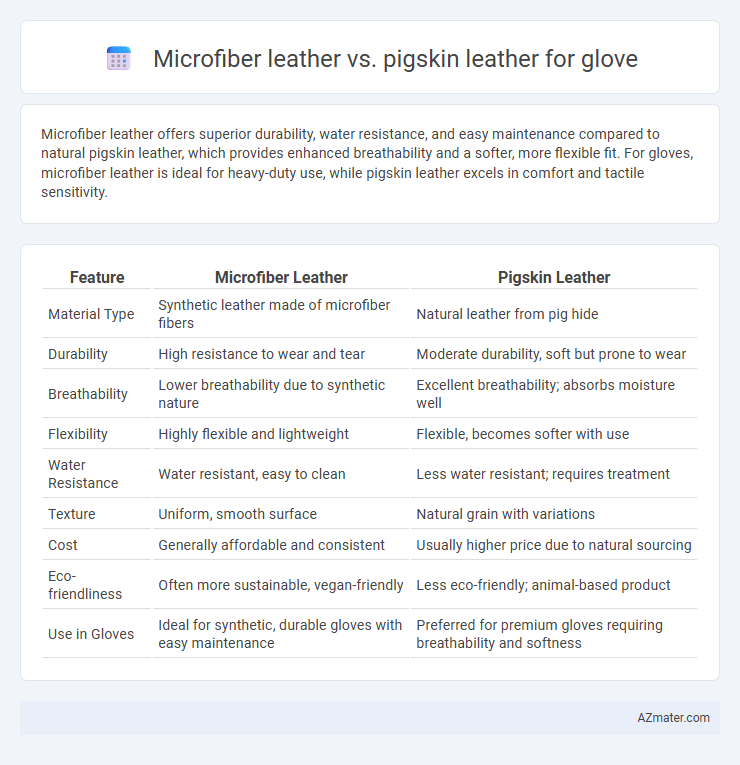Microfiber leather offers superior durability, water resistance, and easy maintenance compared to natural pigskin leather, which provides enhanced breathability and a softer, more flexible fit. For gloves, microfiber leather is ideal for heavy-duty use, while pigskin leather excels in comfort and tactile sensitivity.
Table of Comparison
| Feature | Microfiber Leather | Pigskin Leather |
|---|---|---|
| Material Type | Synthetic leather made of microfiber fibers | Natural leather from pig hide |
| Durability | High resistance to wear and tear | Moderate durability, soft but prone to wear |
| Breathability | Lower breathability due to synthetic nature | Excellent breathability; absorbs moisture well |
| Flexibility | Highly flexible and lightweight | Flexible, becomes softer with use |
| Water Resistance | Water resistant, easy to clean | Less water resistant; requires treatment |
| Texture | Uniform, smooth surface | Natural grain with variations |
| Cost | Generally affordable and consistent | Usually higher price due to natural sourcing |
| Eco-friendliness | Often more sustainable, vegan-friendly | Less eco-friendly; animal-based product |
| Use in Gloves | Ideal for synthetic, durable gloves with easy maintenance | Preferred for premium gloves requiring breathability and softness |
Introduction to Glove Materials
Microfiber leather offers exceptional durability, water resistance, and breathability, making it an ideal choice for performance gloves in sports and industrial applications. Pigskin leather is prized for its natural softness, flexibility, and excellent grip, often preferred in high-quality work and fashion gloves. Both materials provide unique benefits; microfiber excels in maintenance and weather resistance, while pigskin delivers superior tactility and comfort.
What is Microfiber Leather?
Microfiber leather is a synthetic material composed of ultra-fine fibers designed to mimic the texture and durability of natural leather while offering enhanced breathability and water resistance. Compared to pigskin leather, which is known for its natural softness, breathability, and durability, microfiber leather provides greater uniformity, easier maintenance, and increased resistance to wear and stains. In glove manufacturing, microfiber leather combines lightweight comfort with high abrasion resistance, making it a versatile choice for performance and everyday use.
What is Pigskin Leather?
Pigskin leather is a durable, natural leather made from the hide of pigs, known for its softness, breathability, and unique grain texture characterized by visible follicles. It offers superior moisture absorption and breathability compared to synthetic alternatives like microfiber leather, making it ideal for gloves requiring comfort and dexterity. While microfiber leather is valued for its water resistance and low maintenance, pigskin leather provides enhanced tactile sensitivity and long-lasting durability in glove applications.
Key Differences Between Microfiber and Pigskin Leather
Microfiber leather offers superior water resistance and durability compared to pigskin leather, making it ideal for prolonged glove use in harsh conditions. Pigskin leather, derived from pig hide, is naturally breathable and provides a softer, more flexible fit with excellent grip and abrasion resistance. The choice between microfiber and pigskin gloves depends on balancing the need for moisture protection versus natural comfort and tactile sensitivity.
Durability Comparison: Microfiber vs Pigskin Leather
Microfiber leather offers superior resistance to abrasion, water, and stains compared to pigskin leather, making it highly durable for gloves used in harsh conditions. Pigskin leather, while naturally breathable and flexible, tends to wear down faster when exposed to moisture and repeated friction. The synthetic composition of microfiber leather ensures long-lasting performance, maintaining structural integrity longer than pigskin in demanding environments.
Comfort and Flexibility in Gloves
Microfiber leather offers superior softness and breathability, enhancing overall comfort in gloves by reducing hand fatigue during extended use. Pigskin leather provides excellent flexibility and natural durability, molding easily to the hand for a snug fit that improves dexterity. Combining these materials can result in gloves that balance lightweight comfort with responsive movement, ideal for precision tasks.
Breathability and Moisture Resistance
Microfiber leather offers superior breathability compared to pigskin leather, allowing air to circulate more freely and reducing sweat buildup during extended glove use. Pigskin leather, while naturally moisture-resistant due to its dense fiber structure, tends to absorb more moisture over time, which can decrease overall comfort and durability. Microfiber leather's synthetic composition enhances moisture resistance by repelling water and promoting quicker drying, making it an optimal choice for gloves requiring both breathability and moisture management.
Environmental Impact and Sustainability
Microfiber leather for gloves offers a more sustainable alternative by utilizing synthetic fibers derived from renewable resources and producing fewer emissions during manufacturing compared to pigskin leather. Pigskin leather, sourced from animal hides, involves intensive water usage, chemical treatments, and contributes to animal farming emissions, raising significant environmental concerns. Choosing microfiber leather reduces dependency on livestock, lowers carbon footprint, and supports eco-friendly glove production.
Cost Analysis: Which Leather is More Affordable?
Microfiber leather for gloves is generally more affordable than pigskin leather due to lower production and material costs. Pigskin leather involves higher expenses related to animal rearing, processing, and durability treatments, which increases its market price. Choosing microfiber leather offers a cost-effective alternative without compromising significantly on durability and comfort.
Which Leather is Best for Your Gloves?
Microfiber leather offers superior water resistance, durability, and easy maintenance, making it ideal for gloves used in wet or demanding environments. Pigskin leather, known for its softness, breathability, and natural grip, excels in comfort and flexibility, favored for precision tasks like driving or sports gloves. Choosing the best leather depends on glove usage; opt for microfiber leather for rugged, long-lasting performance, while pigskin leather suits applications requiring tactile sensitivity and comfort.

Infographic: Microfiber leather vs Pigskin leather for Glove
 azmater.com
azmater.com